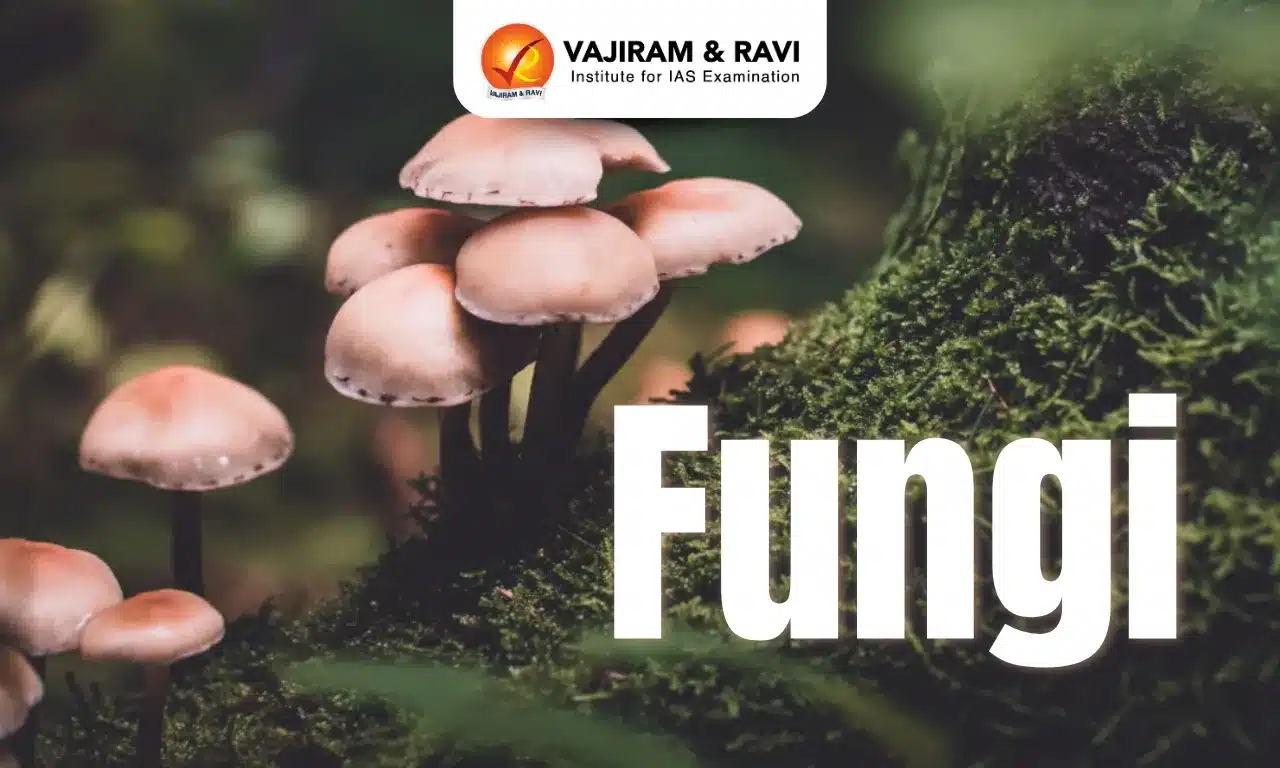Fungi (singular-Fungus) are eukaryotic organisms that include moulds, yeasts, and related organisms like mushrooms within the kingdom Fungi. Fungi come in both unicellular and multicellular forms, with yeast representing the simplest unicellular type and moulds like Rhizopus, Mucor, and Penicillium are examples of multicellular fungi.
They exhibit greater complexity and size compared to bacteria and can function as either saprophytes or parasites. The scientific discipline focused on the study of fungi is known as Mycology.
Cellular structure of Fungi
Fungi are eukaryotic organisms made up of unicellular or multicellular arrangements.
- Cell wall: Fungi constitute cell walls like plants and bacteria. But, their cell walls contain Glucans (basic components), Chitin (for strength), etc.
- Plasma membrane: Their membranes are similar to the animal cells, but they contain ergosterol in the membrane, instead of cholesterol.
- Other organelles: Other organelles like mitochondria, ribosomes, nuclei, etc. of fungi are similar to those of other eukaryotic organisms.
Morphology
Fungi are mostly multicellular organisms, with the exception of a few unicellulars such as yeast, candida, etc. The shape and structure of Fungi is dependent on the environment in which it is growing.
- Hyphae: It is the building block of Fungi that possess tubular structures consisting of a single, uninterrupted cell.
- Stolons are the specialised hyphae which grow horizontally on the surface of a substrate, connecting several groups of hyphae.
- Mycelium: The vegetative part of a fungus consisting mass of branches of thread-like hyphae is called Mycelium.
- Septa: They are internal cross-walls that partition a hypha into one or more cells, each enveloped by a tubular cell wall.
- Septa possess pores of sufficient size to allow the passage of ribosomes, mitochondria, and occasionally nuclei, enabling intercellular communication and exchange.
Nutrition
Fungi thrive most effectively in warm and humid environments.
- Heterotrophs: Like animals, Fungi are heterotrophs. In this regard, they can be either parasitic or saprophytic.
- Most of the Fungi are Saprobes (live on dead organisms). They are important decomposers and recyclers of nutrients within the environment.
- Some of the Fungi function as both internal and external parasites and a few fungi exhibit predatory behaviour. Their prey includes nematodes (roundworms), amoeba, etc.
- Symbiosis: Fungi can also have a symbiotic relationship with others to get their nutrition. For example:
- Lichens is a symbiotic relationship between fungi and algae.
- Mycorhizzaa is a symbiotic association between plant roots and fungi.
Reproduction
Fungi can reproduce both sexually and asexually. Fungi produce spores in sexual reproduction, and sometimes in asexual reproduction as well.These spores disperse from the parent organism by either floating on the wind or by attaching to the animals. For example, Giant Puffball Mushroom.
- Asexual reproduction: Fungi reproduce asexually by fragmentation, budding, or by producing spores.
- For example, Yeast, Saccharomyces pobbe, Rhizopus, etc.
- Sexual reproduction: Sexual reproduction serves as a mechanism to introduce genetic diversity within a population of fungi.
- This process is often triggered by unfavourable environmental conditions.
- In fungi, two distinct mating types are produced. When both of these mating types are present within the same mycelium, it is termed homothallic or self-fertile.
- On the other hand, heterothallic mycelia necessitate the presence of two different yet compatible mycelia for sexual reproduction to occur.
- For Example, Ascospores, Basidiospores, Oospores, Zygospores.
Classification of Fungi
The fungi are divided based on their morphology into four groups, i.e., Yeast, Yeast-like fungi, Filamentous fungi and Dimorphic fungi.
- Yeasts: Yeast cells are oval or round unicellular microscopic organisms, much larger than bacteria.
- They have no flagella or any other structure for locomotion.
- Mostly they are saprophytic fungi that grow abundantly in organic substances which are rich in sugar.
- They are also found in air, soil andanimal excreta.
- Also, some yeasts also occur as parasites in humans.
- Yeasts are mostly beneficial but can be pathogenic to human beings, such as Cryptococcus neoformans.
- Yeast cells typically reproduce through budding and generate spores.
- Yeast-Like Fungi: Yeast-like fungi grow partly as round/oval yeast cells and partly as chains of elongated budding cells forming pseudomycelium.
- For Example, Candida albicans(causes Candidiasis in humans).
- Filamentous Fungi or Moulds: Fungi that form mycelia are called Filamentous Fungi (Mycelial Fungi).
- Examples are Mucor, Rhizopus, Penicillium, and Aspergillus.
- Dimorphic Fungi: These fungi can change from moulds (filament) to yeast forms according to the external conditions.
- These fungi are mostly parasitic and responsible for systemic infections, for example, Histoplasma capsulatium, and Blastomyces dermatidis.
- Dimorphic Fungi as yeast form occur in host tissue and filamentous forms in soil (as a free-living).
Benefits of Fungi for Humans
Fungi have been useful for a long time and even today there are multiple benefits across different fields such as:
- Health and Medicinal benefits:
- The most important benefit of the fungi has been the production of antibiotics.
- Penicillium species such as Penicillium chrysogenum, P. notatum are instrumrntal in synthesising the antibiotics.
- Other fungi such as Trichoderma species (for producing Ciclosporin)are also important in this regard.
- The most important benefit of the fungi has been the production of antibiotics.
- The edible mushrooms are rich in nutrients such as vitamins B, C and D, fibre, and minerals including potassium, phosphorus, and calcium and they are also a good source of protein.
- Some of the edible mushrooms possess medicinal properties, and have been the part of traditional practices.
- For example, Shiitake Mushrooms present antiviral properties and can reduce serum cholesterol.
- Other mushroom species are known to possess a number of other benefits such as inhibiting tumors and the development of AIDS, anti-oxidative properties and antidiabetic effect.
- Economic benefits: Fungi has significant applications in different Industries, such as,
- The fungi Saccharomyces cerevisiae (yeast) is used to convert food i.e. starch and sugar into carbon dioxide and alcohol through the process called fermentation. This is helpful in Alcohol, Bakery, etc. industries.
- Fungi including Aspergillus niger, Rhizomucor miehei, Candida rugosa, etc. are helpful in the production of Biodiesel.
- In paper and pulp industries, several enzymes, such as lipase, amylase, etc are used. Candida cylindracea produces the required lipase.
- They are also useful in leather, textile, detergent making, etc industries as well.
- Ecological benefits:
- Symbiosis of Plants and fungi perform a process called soil carbon sequestration by capturing carbon from the atmosphere and storing it in the soil for a long time (decades). This process also improves soil fertility.
- They are also key players in the carbon cycle within the soil ecosystem. The decomposer fungi recycle carbon from leaf litter and deceased plant matter.
- For example, mycorrhizal fungi.
- Fungi have been found to help degrade various pollutants from the environment, such as plastic and other petroleum-based products, pharmaceuticals and personal care products, and oil.
- Food security and nutrition: Fungi possess the capacity to convert nutrients into forms accessible to plants.
- Some act as decomposers, thereby cycling nutrients and enhancing their availability in the soil.
- They facilitate nitrogen fixation and phosphorus mobilisation, crucial for plant growth and productivity.
- The edible mushrooms can be cultivated using agricultural waste don’t depend on fertile soil and don’t compete for resources with other crops.
- They can reduce agro-waste while increasing food supply, and farmers’ income and generating new employment opportunities.
- Sustainable materials: Mycelium, which is the root structure of mushrooms are now being used to replace unsustainable materials, such as plastic, synthetic and animal-based products.
- The products from Mycelium are biodegradable and require less water and land resources to be produced.
- The mycelium-based products that are already in the market include packaging, clothes, shoes, sustainable leather, skincare products and others.
- Model organism in research: Yeast is considered as the model Eukaryotic organism while doing research by scientists.
Harmful Effects of Fungi
Though fungi offer several benefits for humans as well as the environment, there are a few harmful effects as well. Some of them are as follows:
- Mycotoxins: Many species produce bioactive compounds called mycotoxins, such as alkaloids and polyketides, that are toxic to animals, including humans.
- They contain psychotropic compounds which can cause issues like Hellucination.
- Plant Diseases:
- They are responsible for causing diseases in plants, which can hinder their growth and reduce agricultural productivity.
- For example, Loose Smut of Wheat (leads to 1% damage in the plains and around 10-20% in the foothills and humid regions of Pakistan) or Covered Smut of Barley, etc.
- Animal Diseases:
- Fungi can lead to diseases in animals, impacting both livestock and pets.
- For example, Aspergillosis, Candidiasis in dogs, etc.
- Spoilage:
- Fungi can lead to the decay and spoilage of various materials, including food products, wood, paper, and fabric.
- Human Health:
- Fungal spores and allergens can provoke allergies and respiratory issues in humans.
- In individuals with weakened immune systems, some fungi can cause infections. For example, Black Fungus.
- A few species of mushrooms produce toxins that can be extremely harmful, and even fatal if ingested.
- For Example, Galerina, Lepiota, and Conocybe.
Last updated on November, 2025
→ Check out the latest UPSC Syllabus 2026 here.
→ Join Vajiram & Ravi’s Interview Guidance Programme for expert help to crack your final UPSC stage.
→ UPSC Mains Result 2025 is now out.
→ UPSC Notification 2026 is scheduled to be released on January 14, 2026.
→ UPSC Calendar 2026 is released on 15th May, 2025.
→ The UPSC Vacancy 2025 were released 1129, out of which 979 were for UPSC CSE and remaining 150 are for UPSC IFoS.
→ UPSC Prelims 2026 will be conducted on 24th May, 2026 & UPSC Mains 2026 will be conducted on 21st August 2026.
→ The UPSC Selection Process is of 3 stages-Prelims, Mains and Interview.
→ UPSC Result 2024 is released with latest UPSC Marksheet 2024. Check Now!
→ UPSC Prelims Result 2025 is out now for the CSE held on 25 May 2025.
→ UPSC Toppers List 2024 is released now. Shakti Dubey is UPSC AIR 1 2024 Topper.
→ UPSC Prelims Question Paper 2025 and Unofficial Prelims Answer Key 2025 are available now.
→ UPSC Mains Question Paper 2025 is out for Essay, GS 1, 2, 3 & GS 4.
→ UPSC Mains Indian Language Question Paper 2025 is now out.
→ UPSC Mains Optional Question Paper 2025 is now out.
→ Also check Best IAS Coaching in Delhi
Fungi FAQs
Q1. What are some common types of fungi?+
Q2. What are fungi?+
Q3. What is the difference between fungi and plants?+
Q4. What is the ecological importance of fungi?+
Q5. Can fungi be harmful to humans?Can fungi be harmful to humans?+




























